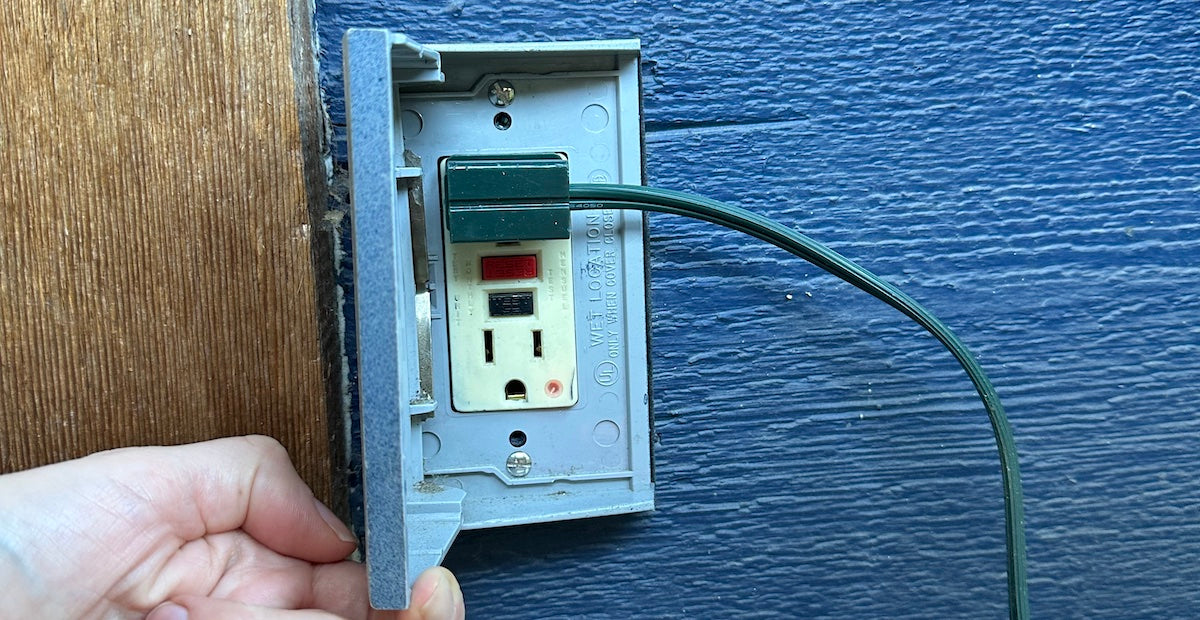Frustrations with tripped GFCI’s are common with Christmas lights. Your lights might be working 100% and then as soon as it rains, a GFCI trips. Christmas lights go up at a time of year where there's a lot of moisture, and there's often a lot of wire to go through for diagnosis. We're here to provide you with some troubleshooting tips to hopefully correct any GFCI issues you may be facing. After all, you should be enjoying all of the hard work you put into your holiday light display - not scratching your head about why it's not working!
What is a GFCI and How Do They Work?
GFCI stands for Ground Fault Circuit Interrupter, and it was designed to protect humans from electrical shock while using electrical appliances. In contrast, circuit breakers - which are what you see in your home's electrical panel - are designed to protect electrical equipment and buildings, and operate completely differently.
Modern plugs have a "hot" and "neutral" side to each outlet. When looking at an outlet, the larger vertical hole is the neutral side, and the smaller vertical hole is the hot side. The flow of power going from hot to neutral should always be the same, but due to environmental conditions like rain, power can be misdirected and funnel into what's called a "ground." A ground is quite literally an object - like a human - that provides an electrical current with connection to the earth. A GFCI outlet has an internal current transformer that detects fluctuations of power greater than 4 to 5 milliamps. When it senses this, the GFCI will shut down the circuit in less than one-tenth of a second, significantly reducing the chance of injury. A GFCI will also trip if more than 15 or 20 amps is drawn, similar to what a circuit breaker does.
Troubleshooting Issues with Your GFCI
Before calling an electrician to help you, try to diagnosis the problem:
Find the Source: Isolate the Problem
Unplug the lights down circuit from the GFCI and reset your GFCI by pushing the button in the center of the outlet. Plug the lights back into the GFCI one section, roofline, or tree at a time. If plugging in a certain section is causing the GFCI to trip, you’ve localized the problem.
Once you know roughly where the issue is stemming from, check the plugs aren’t filled with water. Also check the condition of the wires to make sure they aren’t stretched from leaving in the tree too long, a rodent hasn’t nibbled on them, or a staple hasn’t pierced the wire casing. If you find damage, you'll have to replace the damaged component if possible, or the entire string.
Use a Clamp Meter to Measure Current
It’s also good to know what the current pull is for each feature plugged into the GFCI outlet. This can be accomplished with a clamp meter. If the total current draw is more than what the circuit is designed for, the GFCI will trip (if you don’t have a GFCI, then the circuit breaker at the electrical panel will trip). Generally, most household circuits can accommodate 15 or 20 amps. However, it is strongly advised to err on the side of caution and operate 25-30% below the maximum.
Test Your GFCI For Efficacy
All GFCI’s have a lifespan and eventually wear out, therefore it’s recommended to test them periodically, especially prior to installing lights. Simply push the TEST button to turn power off to the circuit which should cause the RESET button to pop up. You will need to hit RESET to turn the GFCI back on. Do not assume that because an outlet is working that the GFCI protection is in effect. Newer GFCI outlets have an interlock to prevent the outlet from working if the GFCI protection fails, however older GFCI outlets do not have this built-in failsafe.
Reduce the Chances of Your GFCI Tripping
There are several ways to reduce chances of a GFCI tripping. We recommend the following proactive approaches:
1. Use coaxial plugs with rubber o-rings that seal water out from connections.

Our commercial-grade mini lights feature co-axial connections that have a rubber o-ring (the clear plastic ring in the photo above) which protects the electrical connection from incoming moisture and dust build up.
2. Don’t tape your connections.

Tape is not an adequate form of protection from moisture - even electrical tape. It can actually cause moisture to stay in the plugs, never dry out, and form corrosion.
3. Add dielectric grease to your plugs.

This is particularly helpful in really wet climates. For convenience, Big Star Lights also sells male and female zip plugs with dielectric grease pre-loaded.
4. Ensure plugs do not sit in water such as puddles or gutters.
It also helps to prop plugs off the ground in areas that are susceptible to pooling.
5. Ensure water can’t trail downward along the wire into zip plugs.

Simply bend the extension cord so that water drips off the wire before entering the plug. This applies to plug connections at the outlet, as well as where light strings and power cords are connected to one another throughout your installation.
6. Know your electrical limits.
If you are getting too close to the maximum current draw for your wire size, you will risk melting your cables which will of course cause your GFCI to trip as well. You can reference this article on how to determine the maximum number of strings you can connect together safely: Christmas Light Installation: Power, Lengths & Circuits.

